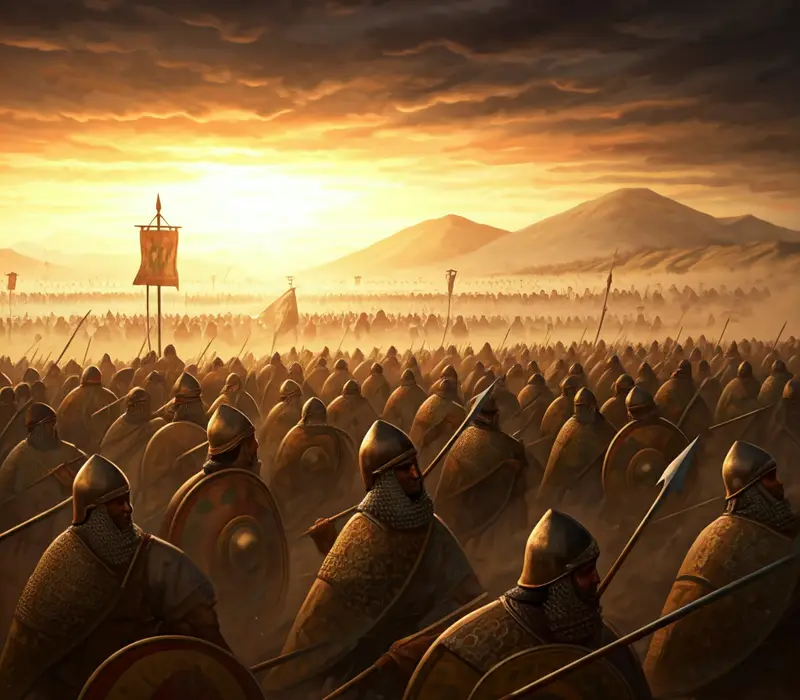The Civil War of Sumer: The Conflict Between Lagash and Umma

In the fertile plains of ancient Sumer, two neighboring city-states—Lagash and Umma—stood as prosperous hubs of agriculture, trade, and development. Located in the northern region of present-day Dhi Qar, Iraq, both kingdoms were thriving centers of civilization. Despite their shared geographical and cultural landscape, their relationship was marred by a fierce rivalry and ongoing conflicts. At the heart of this animosity was a dispute over borderlands and water rights, exacerbated by the desire for dominance. The infamous civil war between Lagash and Umma, which took place around 2600 BCE, is one of the earliest recorded instances of warfare between city-states, marking a significant chapter in Sumerian history.
Origins of the Conflict: A Struggle Over Land and Water
Sumerian documents reveal that the primary cause of the conflict between Lagash and Umma was a disagreement over territorial boundaries and access to vital agricultural lands. These border disputes were particularly critical in a region where agriculture relied heavily on the management of river waters, primarily the Tigris and Euphrates rivers. The fertile soil near these rivers was essential for sustaining the cities' economies, and control over these lands meant control over wealth and resources.
Although many historians agree that the conflict escalated significantly during the reign of King Eannatum of Lagash, who ruled around 2500 BCE, some scholars argue that the tensions had been brewing long before his time. Various sources suggest that the animosity between Lagash and Umma dated back years, possibly decades, before Eannatum's reign.
One alternative theory suggests that the wars between the Sumerian cities were not solely driven by disputes over land and water. Instead, it is proposed that these conflicts were part of a larger struggle for political unification, with each city-state attempting to bring all of Sumer under its control. This desire for dominance created a cycle of warfare that persisted for centuries.
The Role of King Mesilim of Kish in Drawing Boundaries
The roots of the Lagash-Umma conflict can be traced to the reign of King Mesilim of Kish, who played a pivotal role in the early stages of the dispute. Around 2600 BCE, Mesilim intervened in the territorial dispute between Lagash and Umma, attempting to mediate the conflict. He established the boundaries between the two city-states using stone markers and steles, a common practice in Sumerian diplomacy.
However, Mesilim's decision to favor Lagash in the boundary demarcation led to further tensions. The fertile and productive lands were awarded to Lagash, leaving Umma with less arable and more barren land. This perceived injustice sparked anger among the people of Umma, who felt wronged by the decision and sought to regain their lost territories.
Uru'inimgina of Umma and Eannatum of Lagash: A War for Retribution
As the situation escalated, Umma, under the leadership of its ruler Uru'inimgina, made repeated attempts to reclaim the disputed lands. Uru'inimgina viewed Mesilim's boundary decision as illegitimate and began organizing rebellions and military campaigns against Lagash. These efforts, however, were met with strong resistance from Lagash, whose ruler, Eannatum, was equally determined to defend his city's territorial claims.
The war between the two city-states reached its peak during the reign of Eannatum. Known for his military prowess, Eannatum led the forces of Lagash in a series of battles against Umma. The fighting was brutal and intense, with both sides suffering heavy casualties. Eannatum's forces ultimately emerged victorious, securing Lagash's control over the disputed lands.
The Stele of the Vultures: A Monument to Victory
To commemorate his victory, Eannatum commissioned the construction of the famous Stele of the Vultures. This monumental stone carving depicts the soldiers of Lagash trampling over the bodies of their enemies from Umma. The stele is a vivid representation of the brutality of the conflict, symbolizing Lagash's dominance over its rival city-state.
The Stele of the Vultures also serves as a testament to the importance of warfare in Sumerian society. In addition to depicting scenes of battle, the stele highlights the role of the gods in determining the outcome of the conflict. Eannatum is shown receiving divine approval for his actions, reinforcing the idea that the gods favored Lagash in the war against Umma.
The Aftermath: Harsh Terms for Umma
Following its defeat, Umma was subjected to harsh terms by Lagash. As part of the peace settlement, Umma was required to build a canal along the newly established border and pay substantial tribute to Lagash in the form of barley and wheat. These terms were designed to weaken Umma economically while reinforcing Lagash's control over the disputed territories.
Despite the humiliating defeat, the conflict between Lagash and Umma did not end with this peace agreement. After Eannatum's death, new leaders rose to power in both cities, and the cycle of warfare resumed. The legacy of the Lagash-Umma conflict continued to shape the political landscape of Sumer for centuries to come, as other city-states sought to assert their dominance and control over the region.
The civil war between Lagash and Umma is a compelling example of the complexities of Sumerian politics and warfare. While the conflict was ostensibly about control over land and water, it was also a reflection of the broader struggle for power and influence in ancient Mesopotamia. The desire for dominance, the role of divine authority, and the economic significance of agricultural resources all played crucial roles in shaping the outcome of the war.
For modern travelers interested in exploring the history of Iraq, the story of Lagash and Umma offers valuable insights into the region's rich cultural heritage. The remnants of these ancient city-states, along with artifacts like the Stele of the Vultures, provide a window into a time when the fate of entire civilizations hung in the balance of war and diplomacy.